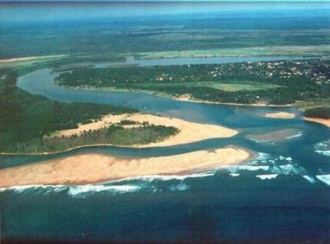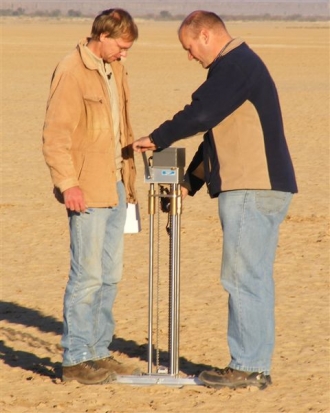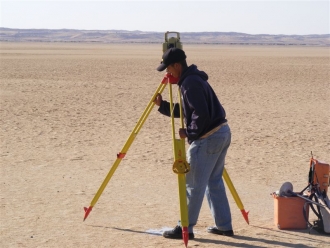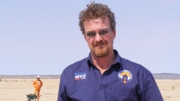
by Rudi Riek
You might be disappointed to learn that we have postponed the track preparation slightly but take heart, it is for a very good reason.
Back in 1997 when the previous record was broken the state of our environment was not as in the forefront of everyone’s mind as it is today and, even though the Thrust SSC team received an award for their environmental consciousness back then, we have quite a number of additional requirements that need to be met with this run.
The South African Government has recently revised its Environmental laws and as someone explained to me the new laws have a considerable amount of additional teeth. According to the experts, we now have some of the most progressive Environmental legislation worldwide.

St Lucia, South Africa – a typical wetland
You see, pans such as Hakskeenpan are categorized by definition as wetlands “A wetland is an area of land whose soil is saturated with moisture either permanently or seasonally. Such areas may also be covered partially or completely by shallow pools of water. Wetlands include swamps, marshes, and bogs, among others.” Source: Wikipedia
Although Hakskeenpan is only saturated with water for a month or so each season it still needs to be managed within the legislation as a wetland.
BLOODHOUND’s mission, you might remember, is “To confront and overcome the impossible using science, technology, engineering and mathematics and to motivate the next generation to deal with global 21st century challenges.”
It should be clear now, that rather then viewing this new development as an obstacle, we view it as an opportunity to expand our learning material to include environmental science, and also to prove that running a supersonic car and the activities associated in doing so can be managed in an environmentally conscious way.
Our aim will be not only to comply with the legislation, but to expand on it by doing everything possible to do all our activities in a “green” manner.

Johan and Pierce taking a
penetrometer reading to determine
the hardness of the pan
During the past week our team in South Africa was quite busy. We had a team of soil specialists, a team of environmental consultants and a surveyor all working simultaneously.
Johan van Der Waals (PhD Soil Science (UP), Pr.Sci.Nat) and CEO of TERRASOIL Science had a team of five scientists on the pan. I don’t want to elaborate too much on what they did because Johan will provide us with a report that we will publish once he has processed all his data. I can tell you, however, that his team collected data from many points on the track at 1 km intervals, including a detailed penetrometer reading, crust samples in search of one-celled organisms and a soil sample obtained by hand auger. The information generated will not only be highly applicable to BLOODHOUND but Johan plans to publish several articles for the scientific community with his findings. Without letting the cat out of the bag, it was found that Hakskeenpan was consistently hard, had a completely homogenous surface and contains highly dispersive soils which means that it will recover very quickly from any disturbance.

Setting up yet another survey point
We would like to thank TERRASOIL for providing their services on a pro bono basis to BLOODHOUND and look forward to the detailed report.
Willem van Der Frey (BSc Botany & Zoology (UP), BSc (Hons) Wildlife Management (UP), MSc Wildlife Management (UP)) is the owner of EkoInfo. Willem and his team are environmental consultants and also agreed to do their initial assessment on a pro bono basis.
Willem spent three days on the pan looking for signs of wildlife and plant life in addition to looking at how the impacts of the BLOODHOUND team will be managed with regards to waste removal, recycling, storage of fuels and various other aspects. Willem also looked at the potential actions that would trigger the new environmental legislation.

Soil samples were collected with a hand auger
After our initial assessment we met with Mr. Albert Mabunda, Director of Conservation and Environmental affairs and also Director of the Green Scorpions for the Northern Cape. The Green Scorpions are the department tasked with policing our environmental laws.
It was agreed at the meeting that even though the speed record itself is not a listed activity with regards to our legislation, there are other potential triggers pertaining to air pollution, fuel management, etc., that would require us to do an Environmental Impact study and then develop an Environmental Management Plan. Although it sounds scary, it is actually a good thing because it will protect BLOODHOUND and the Northern Cape government and prove that we have followed the correct procedures.
The next step is for the Northern Cape Government to appoint an Environmental consultant and then the approximately six month process of the EIA (Environmental Impact Assessment) will take place.
Track preparation however will be able to continue as it will become part of the Environmental Management plan, but also because the activities associated with the preparation are not listed activities. We will be removing a manmade road, thus rehabilitating the pan, as well as removing stones by hand, thus the impact of the stone removal is minimal. We will always have an Environmental control officer with us to ensure that our activities comply with our environmental laws.
We hope to start with track preparation by the 1st of September 2010.


